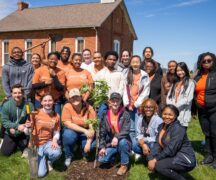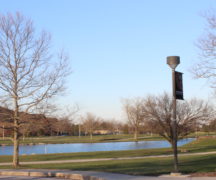By DAVID DUPONT
BG Independent News
Several dozen people waited in line Tuesday morning to get the first chance to buy the thousands of items Bowling Green State University students have left behind.
Tuesday was the first of the two-day reStore Thrift sale open to BGSU students, staff and faculty. The goods—from appliances to underwear (freshly laundered) – was accumulated through the Office of Sustainability’s When You Move Out, Don’t Throw It Out.
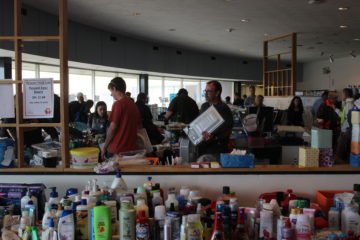 Now the fridges, microwave ovens, TVs, fans, sweatshirts, unopened boxes of tissues, mirrors, stack of Solo cups and more that would have been destined for the landfill, is now being carried out the door by new owners, pleased with the great deals they’ve gotten.
Now the fridges, microwave ovens, TVs, fans, sweatshirts, unopened boxes of tissues, mirrors, stack of Solo cups and more that would have been destined for the landfill, is now being carried out the door by new owners, pleased with the great deals they’ve gotten.
And there’s more to sell than ever before, said Nick Hennessey, the BGSU sustainability coordinator. This is the third year of the sale, and the 16th for the When You Move Out, Don’t Throw Out program.
This year, he said, they had more of everything, except for devices such as alarm clocks and calculators “that have been obviated by the use of cell phones.”
In each of the past two years, the sale has brought in about $3,000. Hennessey said the sale made that much just on Tuesday. The money goes to promote sustainability efforts on campus. It will be open Wednesday again from 9 a.m. to 4p.m. “with deals all day,” he promised.
The sale is just part of how the goods collected at the end of the year are distributed. Non-profits including the Cocoon come in ahead of the sale to pick up items they may need. About a half-dozen food pantries also come in to collect food items and toiletries. The food stocks were “voluminous,” Hennessey said. Everything left after Wednesday, which given the business on Tuesday may not be much, will be distributed to various charities.
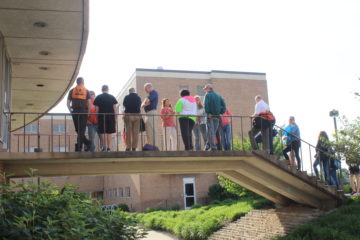
Shoppers line up outside Harshman Community Room waiting for reStore Thrift Sale to open.
For Kevin Neves, a biology instructor, this is one of his lessons come to life. In introduction to environmental science, he teaches the three Rs – reduce, recycle reuse.
“To see the university put so much effort into this is phenomenal,” he said.
He remembered his own undergraduate days, seeing all the stuff piled up by the dumpsters. Now it occupies the entire Harshman Community Room, and several adjacent spaces that house furniture futons and pillows.
“It has to go somewhere,” he said. “Where would it go?”
Neves said he had just moved into a new place and was looking for those odds and ends he still needed, like a fan to deal with Northwest Ohio’s unpredictable weather.
Neves said while the amount of stuff available was “eye-popping,” he didn’t find it surprising.
Joyce Okango, a graduate student from Kenya, was perusing the aisles with her friend Pempho Chinkondenji, a graduate student from Malawi.
Okango was a little taken aback by all the stuff that students had discarded. “In my culture, my mother would have spanked me” for throwing out so much. “This is worth thousands of dollars,” she said gesturing to the tables laden with cast-off valuables.
Still she and Chinkondenji were happy to have the opportunity to shop here. “It’s cheaper to buy it here than at the store.”
They had their eyes out for clothing and lamps, and other household goods.
“Maybe shoes,” Chinkondenji said. “Anything fancy.”
Linsay Cramer, a newly minted PhD in media and communications, said she was surprised by the piles of clothing and household appliances. “Maybe people just can’t move it.”
“Rather than putting it in the dump, it’s better to resell it and have people reuse it.”
She was there with her husband and young daughter. They’d come last year, and found clothes, office supplies, and even toys for the little one.
All for a few dollars.
Bonnie Burris, who works in admissions, came with a long list.
Her daughter Karen is just starting her teaching career at Glass City Academy in the fall. She’s out of state for another job right now, so her mother is hunting for everything she needs to equip her classroom.
After shopping Burris will don a yellow vest and volunteer to help keep the sale running.
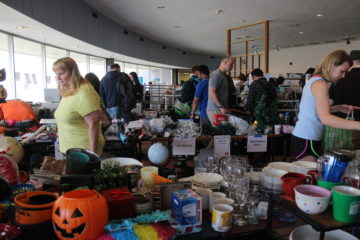 She’s been involved for the past couple years, she said. “More people realize they don’t have to toss it in the dumpster, they can bring it here. That’s what’s so great.”
She’s been involved for the past couple years, she said. “More people realize they don’t have to toss it in the dumpster, they can bring it here. That’s what’s so great.”
The question hanging over the sale is where it’ll be held next year. Harshman is being torn down.
Hennessey said the best bet is somewhere in Kreischer, which is a mirror image of Harshman. However, Kreischer has been divide into smaller spaces, so that may be problematic.
Regardless the plan is to continue it, he said.
If the sale wasn’t held maybe someone else would pick up the ball, or people would find other places to donate their goods, or maybe they would haul them home.
But, he said, more of it would inevitably end up going to landfill.


